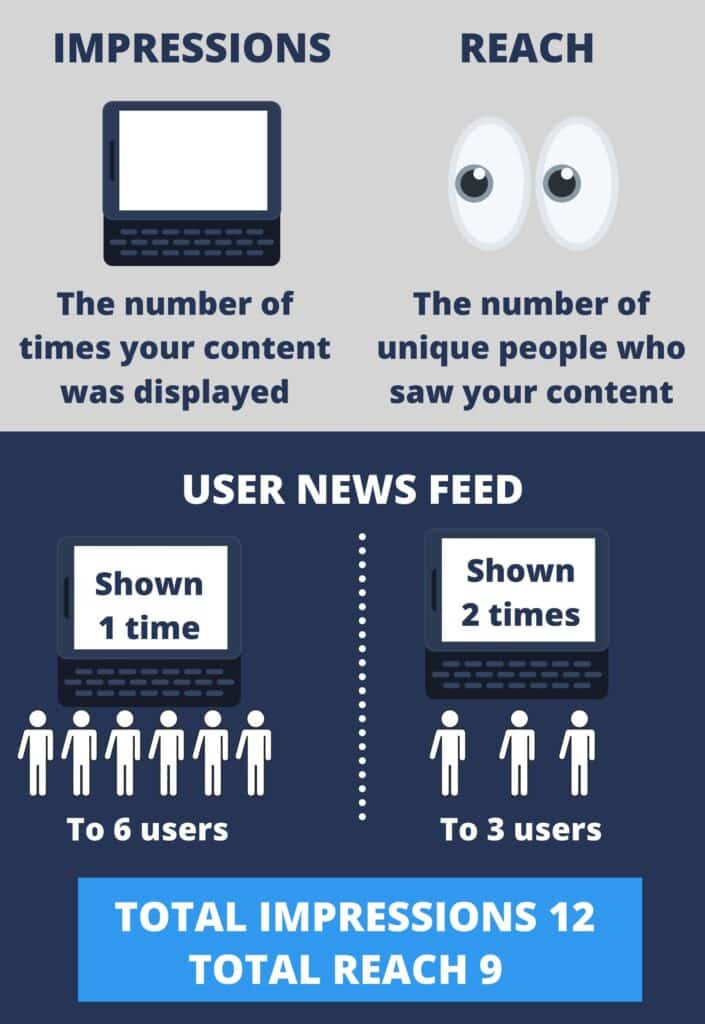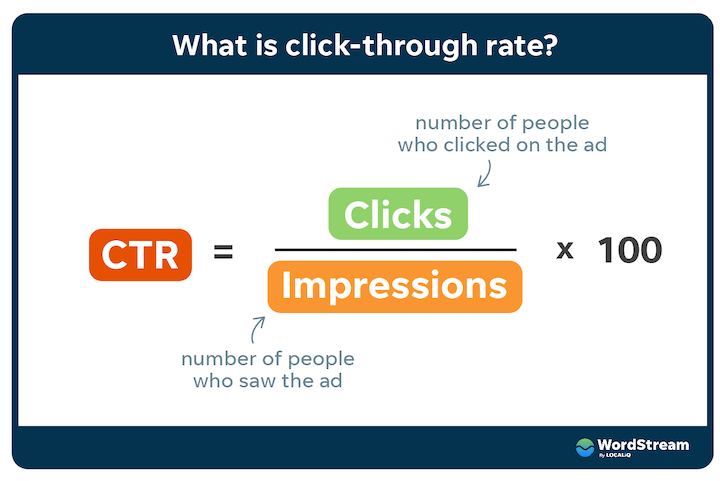If you work in social media marketing, you have probably asked yourself this question:
How to know if a social media strategy is helping a business reach its goals?
The answer is simple: social media metrics.
You can’t afford to ignore them if you want to create an effective digital marketing strategy.
In this blog post, you’ll discover the top social media metrics to track and how to measure them.
- What are Social Media Metrics?
- Why Should Marketers Track Them?
- Top Social Media Metrics to Track
- Wrap Up: Tracking Social Media Metrics is Vital to Any Social Media Strategy
Download this post by entering your email below
What are Social Media Metrics?
Social media metrics are the data you use to determine the effectiveness of your social media strategy.
Different social media platforms provide you with lots of information about the way people are discovering and interacting with your brand.
By focusing on the most important metrics, you can see what you’re doing well and what you need to improve.
This will allow you to adjust your social media strategy and make a positive impact on your brand.
Why Should Marketers Track Them?
Social media metrics are important because they allow you to determine whether or not you are making progress toward your goals.
Each goal needs a related metric to measure your efforts, and having clearly defined goals is essential for any social media strategy.
If you’re not tracking progress toward clear goals, you are playing a guessing game.
With all the data social media platforms provide you, you can be much more intentional about the way you produce content for social media.
As a digital marketer, social media metrics also give you hard data to present to executives or the people you work with to show them the value you bring to the brand.
If you can prove that your social media strategy is adding value to the business, you’ll likely be rewarded with more resources.
This, in turn, allows you to have an even bigger impact on the business.
Top Social Media Metrics to Track
By looking at your data, you can get a better idea of how your digital marketing funnel is performing.
For example, you may determine that you’re doing a really good job at the top of the funnel if the data tells you a lot of people are seeing your content.
However, the data may also tell you that people aren’t engaging with your content enough, signaling that you may be struggling in the middle of your funnel and that you need to make adjustments to the type of content you’re creating.
Every business will have different things they need to focus on, and there’s no one-size-fits-all solution.
However, one thing is true for all brands: social media metrics help you determine the adjustments you need to make to your strategy.
→ Social Media Metrics to Track Awareness
The first stage in your marketing funnel is awareness. This is when people are exposed to and discover your brand.
There are three metrics you’ll want to focus on to track your progress in this stage.
1. Impressions
Impressions are the number of times your content is shown to users.
It is important to remember that one user can count for multiple impressions.
For example, if you have 500 followers and each of them sees your content two times, you would have 1,000 impressions.
Impressions are important because they measure your ability to get your content in front of your audience.
A user will likely need to be exposed to your brand multiple times to become aware of it, so increasing your number of impressions could be a goal you want to focus on to increase the awareness of your brand.
2. Reach
Reach is the number of users who see your content, even if they see your content multiple times.
For example, if you have 500 followers and each of them sees your content two times, your reach is still only 500.
Reach is an important metric because when you reach a new user, they are getting their first exposure to your brand.
If you track your reach, and it’s low, you may want to consider a strategy for getting your content in front of new users.
3. Audience growth rate
The audience growth rate is the speed at which your number of followers grows.
This metric is more useful than a pure follower count because it allows you to set clear goals.
For example, increasing your follower count by 30% over the next 3 months is a better goal than simply increasing your number of followers over an undefined period of time.
This is an important metric to track because it will give you an idea of whether the content you are using to reach new potential followers is working.
If you have a high number of impressions and a large reach, but your follower count isn’t rising, you may want to reconsider the content you are using to expose them to your brand.
→ Social Media Metrics to Track Engagement
Once users have become aware of your brand, they enter the consideration stage of the marketing funnel.
It’s here that you want them to engage more with your brand — which brings us to the first metric.
4. Engagement rate
Engagements include the number of likes, comments, and shares on your content.
However, if you want them to engage with your brand, you need to create content they will enjoy or find useful.
Engagement rates help you determine the quality of your content by understanding how actively involved your audience is with your publications.
This rate is calculated by dividing your number of engagements by either your impressions or your reach.
The higher your engagement rate, the more actively involved your audience is. The more actively involved your audience is, the easier it will be to convert them into customers.
It’s also important to remember that different stages in your marketing funnel don’t operate in a silo.
For example, getting a lot of shares on your content indicates high engagement from your audience.
But this also contributes to your brand awareness.
The more people are sharing your content, the more people will see your content, boosting your impressions and reach.
5. Click-through rate
You’ll also want to track your engagement by measuring your click-through rate.
Click-through rate is the percentage of times a user sees a link to your content and clicks on it to get your website.
This rate is calculated by dividing the number of clicks on your link by the number of impressions.
If you have a high click-through rate, it indicates you are providing content that people find interesting and want to engage with.
However, it’s important to keep in mind that you want to share quality content and maintain a low bounce rate.
6. Bounce rate
Bounce rate is the percentage of users who visit your page and leave without clicking on any other pages.
A high bounce rate indicates that people don’t want to engage with more of your content after they visit your first page.
You’ll also want to maintain a high average time on the page.
7. Average time on page
Average time on page is the amount of time each user spends on your page.
If you’re providing engaging content, the users visiting your site should stay for a while and check out other content on your site.
If your bounce rate is high and your average time on the page is low, you’ll likely want to consider making adjustments to your content to make it more engaging for users.
You can track these metrics using a free tool like Google Analytics.
8. Sentiment Analysis
Sentiment analysis evaluates the emotional tone of user interactions with your brand on social media. It helps you understand whether the sentiment is positive, negative, or neutral.
Monitoring sentiment allows you to gauge your brand’s reputation and perception among your audience.
Positive sentiment indicates a strong brand image and customer satisfaction, while negative sentiment might signal areas for improvement or potential issues that need addressing.
9. Brand Mentions
Brand mentions referring to the number of times your brand or business is mentioned by users on social media platforms, either in posts, comments, or tags.
Positive mentions can indicate satisfied customers and brand advocates, while negative mentions may highlight areas for improvement or customer concerns.
By monitoring brand mentions, you can proactively engage with your audience, respond to feedback, and address any issues to maintain a positive brand image.
Additionally, tracking brand mentions helps you identify opportunities for user-generated content and measure the impact of influencer marketing strategies.
→ Social Media Metrics to Track Conversions
As users make their way through your marketing funnel, they come to the conversion stage.
This is where members of your audience take the action you want them to.
For businesses, this will typically be when a user purchases the product you sell.
However, the conversion could also be a different action like downloading an eBook or signing up for your newsletter. It depends on the goals of your brand.
In order to track if your social media audience is converting, you’ll want to track your social media referrals.
10. Referrals
Referrals are the source from which a user came to your website or landing page.
Google Analytics will provide you with a breakdown of your traffic from each social media platform.
This will give you an idea of which of your social media accounts are driving traffic so you can adjust your strategy accordingly.
For example, if you’re getting a lot of referrals from Instagram, but not Twitter, you may want to change your Twitter strategy.
You may also consider investing more resources into your Instagram marketing efforts since you know your strategy is working well on that platform.
Finally, if you’re running ads, you’ll also want to track your cost-per-click (CPC).
11. Cost-per-click
Cost-per-click is the amount of money it costs you for each click on one of your ads.
If you have a high cost-per-click but that traffic isn’t converting, you’ll likely want to adjust your strategy.
Whether or not your strategy is worth pursuing will depend on your ROI, or Return on Investment.
ROI is the amount of money you make after investing money in a strategy.
For example, if you invest $100 in an ad campaign, and that campaign generates $200 in sales, your profit is $100, and your ROI is 100%.
Whether or not the campaign is successful will always depend on your goals and these will be different for every brand.
However, by tracking your metrics, you have the tools to measure your goals.
→ Social Media Metrics to Track Customer Care
The final stage of your funnel is retention and customer care.
Once a user converts, you’ll want to make sure you are still meeting their needs so they become repeat customers or ambassadors for your brand.
There are two metrics you’ll want to focus on here.
12. Response rate
The response rate is the percentage of your audience to whom you are responding. For instance, if your account received 25 comments and 25 messages, and you responded to 25 of those, your response rate would be 50%.
This metric is simple yet essential in nurturing your relationship with your audience, allowing you to set clear goals for your social media strategy.
For example, you may set a goal of achieving a 100% response rate and a 5-hour response time to demonstrate your commitment to customer care.
13. Response time
Response time refers to how long it takes you to reply to your audience’s comments or messages. Timely responses are crucial in maintaining a positive relationship with your followers.
Ensuring a swift and thoughtful response to customer inquiries shows that you value their engagement and feedback. By tracking this metric, you can continuously improve your responsiveness and enhance customer satisfaction.
Wrap Up: Tracking Social Media Metrics is Vital to Any Social Media Strategy
Social media platforms offer a wealth of valuable data about your audience, empowering you to make informed decisions.
By prioritizing essential metrics, you can set clear goals and easily monitor your progress toward achieving them. However, as a digital marketer, there’s a whole array of other metrics worth tracking, and you can explore them further in our comprehensive guide to digital marketing metrics.
Remember, achieving outstanding numbers requires high-quality content. To secure good metrics like low bounce rates, extended average time on page, and valuable brand mentions, invest in compelling content creation.
Elevate your social media strategy to new heights by partnering with professional writers. Try out WriterAccess’ free trial today, and our skilled writers will expertly represent and embody your brand’s voice.
Your journey to social media success begins now!











